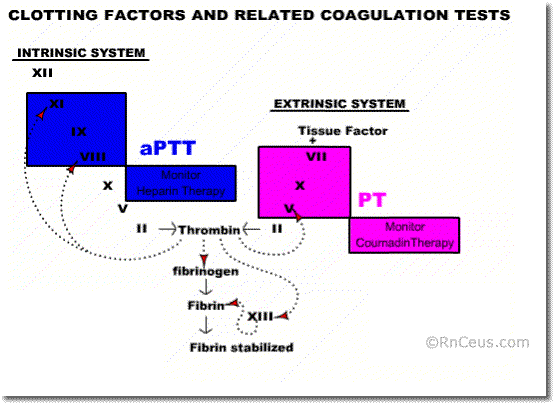Blood coagulation is a process that changes circulating substances within the blood into an insoluble gel. The gel plugs leaks in blood vessels and stops the loss of blood. The process requires coagulation factors, calcium and phospholipids.
The coagulation factors (proteins) are manufactured by the liver.
Ionized calcium ( Ca++ ) is available in the blood and from intracellular sources.
Phospholipids are prominent components of cellular and platelet membranes. They provide a surface upon which the chemical reactions of coagulation can take place.
Coagulation can be initiated by either of two distinct pathways.
The Intrinsic pathway can be initiated by events that take place within the lumen of blood vessels. The Intrinsic pathway requires only elements (clotting factors, Ca++, platelet surface etc.) found within, or intrinsic to the vascular system.
The Extrinsic pathway is the other route to coagulation. It requires Tissue Factor (tissue thromboplastin), a substance which is "extrinsic to", or not normally circulating in the vessel. Tissue Factor is released when the vessel wall is ruptured.

Regardless of whether the Extrinsic or Intrinsic pathway starts coagulation, completion of the process follows a common pathway. The common pathway involves the activation of factors: X, V, II, XIII and I. Both pathways are required for normal hemostasis and there are positive feedback loops between the two pathways that amplify reactions to produce enough fibrin to form a lifesaving plug. Deficiencies or abnormalities in any one factor can slow the overall process, increasing the risk of hemorrhage.
The coagulation factors are numbered in the order of their discovery. There are 13 numerals but only 12 factors. Factor VI was subsequently found to be part of another factor. The following are coagulation factors and their common names:
Factor I - fibrinogen
Factor II - prothrombin
Factor III - tissue thromboplastin (tissue factor)
Factor IV - ionized calcium ( Ca++ )
Factor V - labile factor or proaccelerin
Factor VI - unassigned
Factor VII - stable factor or proconvertin
Factor VIII - antihemophilic factor
Factor IX - plasma thromboplastin component, Christmas factor
Factor X - Stuart-Prower factor
Factor XI - plasma thromboplastin antecedent
Factor XII - Hageman factor
Factor XIII - fibrin-stabilizing factor
The liver must be able to use Vitamin K to produce Factors II, VII, IX, and X. Dietary vitamin K is widely available from plant and animal sources. It is also produced by normal intestinal flora. A deficiency is rare but may occur:
in newborns because they must first develop normal flora to produce Vitamin K, or
when the flora is disturbed by broad-spectrum antibiotics.
At birth and throughout childhood, Factor VIII levels are the same as adult values. Many other factor levels are below adult levels at birth, some as low as 10% of adult levels. Theses levels increase toward the adult levels by age 6 months, although they may remain mildly below adult normal range throughout childhood. Despite lower levels, newborns and children do not normally experience bleeding. This confers some level of antithrombolic protection in youth. During pregnancy Factor XI can decrease, but fibrinogen and factor VIII increase.

0 comments:
Post a Comment